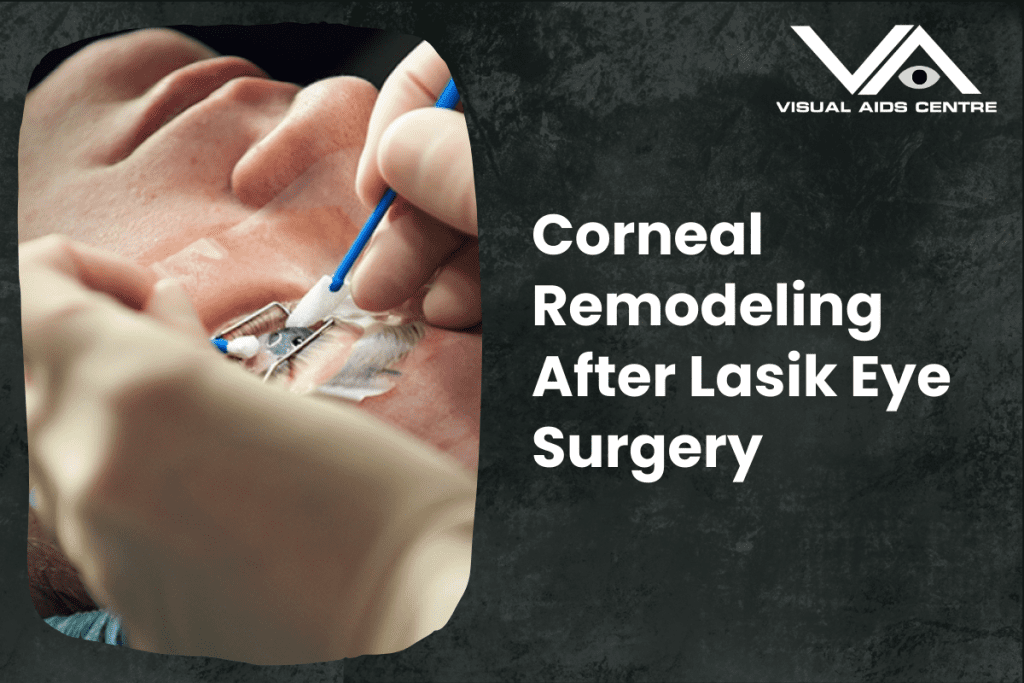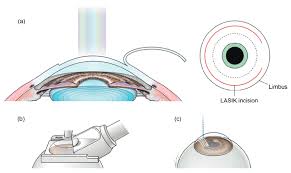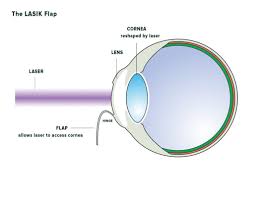Table of Contents
ToggleCorneal remodeling after LASIK eye surgery refers to the natural healing and structural adjustment processes the cornea undergoes after being reshaped to correct vision problems.
These changes are vital for stabilising vision and achieving the desired outcomes of the procedure.
For anyone who has undergone LASIK or is considering it, understanding corneal remodeling is key to appreciating how vision correction works and managing expectations regarding recovery. This blog dives deep into the science behind corneal remodeling, the factors influencing it, and what patients and professionals need to know.

What Happens to the Cornea During LASIK?
LASIK eye surgery (Laser-Assisted in Situ Keratomileusis) is a highly advanced procedure that reshapes the cornea to resolve vision issues like myopia (nearsightedness), hypermetropia (farsightedness), and astigmatism. The surgery involves two main steps:
1. Creating a Corneal Flap:
A thin flap is made on the cornea’s surface using a femtosecond laser or a microkeratome blade. This flap allows access to the underlying stromal tissue.
2. Reshaping the Cornea:
An excimer laser carefully removes microscopic amounts of corneal tissue to reshape the stroma and correct how light is focused on the retina.
The precise changes depend on the patient’s unique refractive error. After the reshaping, the corneal flap is repositioned, and natural healing begins.
What is Corneal Remodeling?
The term “corneal remodeling” describes the biological and structural changes the cornea undergoes after LASIK surgery. It includes:
- Wound Healing Process:
The cornea’s cells repair any damage caused by the surgical procedure, ensuring structural integrity and clarity.
- Biomechanical Stabilisation:
The cornea adjusts to the removal of tissue, redistributing stress and settling into its new shape over time.
Phases of Corneal Remodeling
The corneal remodeling process occurs in distinct phases:
1. Immediate Post-Surgical Response (Hours to Days Post-Surgery):
- The epithelial layer of the cornea begins healing almost immediately after surgery.
- Early epithelial healing ensures protection of the eye from infection and external irritants.
- Patients often experience some visual fluctuations, glare, and dryness during this phase.
2. Intermediate Remodeling (Weeks Post-Surgery):
- Stromal healing begins, where the deeper tissue forms orderly collagen alignment following the tissue removal.
- The corneal nerves, temporarily severed during the procedure, start regenerating, which might affect the production of tears and contribute to temporary dry eye symptoms.
3. Long-Term Stabilisation (Months to Years Post-Surgery):
- Permanent structural adjustments occur as the corneal collagen redistributes to stabilise its new shape.
- Vision clarity and consistency improve, with most patients experiencing long-term stability after three to six months.
These phases are crucial for understanding the recovery period and why vision may fluctuate post-surgery.
Factors That Influence Corneal Remodeling
Every patient’s corneal remodeling experience is unique. Various biological and procedural factors can influence how the cornea changes and heals after LASIK:
1. Pre-Existing Corneal Thickness
The thickness of the cornea plays a critical role. Patients with thinner corneas may experience slower remodeling due to the limited amount of tissue available for reshaping.
2. Age of the Patient
Corneal remodeling tends to occur more efficiently in younger patients due to faster tissue regeneration and healing capacity. Mature patients may require longer recovery timelines and experience slightly different healing dynamics.
3. Laser Technology Used
The precision of the excimer laser is vital. Advanced laser technology can perform highly accurate corneal reshaping, minimising unnecessary tissue removal and ensuring smoother remodeling.
4. Post-Surgical Care
Adhering to post-operative instructions, such as using prescribed eye drops and avoiding eye strain, significantly impacts the healing process. Non-compliance can lead to complications or slower remodeling.
5. Ocular Surface Health
Eye health before and after LASIK, including tear film stability and hydration levels, plays a crucial role in supporting the proper remodeling of the corneal tissue.
6. Lifestyle Factors
Factors like smoking, poor diet, or exposure to environmental pollutants can impede healing and remodeling. Patients with healthier habits typically experience more effective recovery.
Role of Biomechanics in Corneal Remodeling
Corneal biomechanics refers to the structural properties of the cornea that allow it to maintain its flexibility while holding its shape. LASIK alters these physical properties when removing corneal tissue.
- Stress Redistribution:
After LASIK, the stress distribution across the cornea changes. The corneal remodeling process aims to balance this stress to stabilise the new shape.
- Collagen Arrays:
Collagen fibrils make up the stroma’s framework. LASIK disrupts these fibrils, prompting the corneal remodeling process to realign and stabilise them.
Maintaining biomechanical stability is critical to avoid post-surgical complications, such as corneal ectasia (a rare but severe thinning and bulging of the cornea).
How Long Does Corneal Remodeling Take?
While the most noticeable improvements in vision occur within the first few weeks, corneal remodeling continues well beyond this period. For the majority of patients:
- Substantial healing occurs within 3–6 months.
- Long-term stabilisation is usually achieved within 6–12 months post-surgery.
However, subtle changes can continue for years, especially among younger patients with more active tissue regeneration.
Signs That Corneal Remodeling is Progressing Well
Patients can monitor their healing progress with professional oversight. Positive indicators include:
- Improved Visual Acuity:
Gradual improvement in vision to meet the post-surgical expectations.
- Reduced Visual Fluctuations:
Vision stabilises over time, with decreasing instances of glare or halos.
- Absence of Complications:
No signs of infection, inflammation, or structural irregularities.
Potential Challenges in Corneal Remodeling
While LASIK is a safe and effective procedure for most patients, some may experience slower or less predictable corneal remodeling. Challenges can include:
1. Dry Eye Syndrome
Reduced tear production due to nerve interruption can prolong remodeling. Artificial tears or lubricating drops are essential during recovery.
2. Regression
Small vision changes may occur as the cornea adjusts. These are typically minor but may require further follow-up or enhancements.
3. Corneal Ectasia
This rare complication involves the cornea losing its structural integrity. Proper pre-surgical evaluation and advanced diagnostic tools help mitigate this risk.
4. Persistent Glare or Halos
Some patients may experience prolonged symptoms of light sensitivity, especially in low-light conditions, which taper off as the remodeling progresses.
Importance of Follow-Up During Corneal Remodeling
Regular follow-up appointments are essential after LASIK surgery to monitor corneal remodeling. These visits allow eye surgeons to:
- Check for any signs of complications.
- Evaluate the long-term stability of the cornea.
- Adjust post-operative care or recommend enhancements if needed.
Patients should communicate openly with their eye care provider about concerns like prolonged vision fluctuations or discomfort.
Final Thoughts on Corneal Remodeling
Corneal remodeling after LASIK is a natural and critical part of the healing process, enabling patients to achieve stable, enhanced vision. Understanding the phases of remodeling, factors influencing the process, and potential challenges equips patients with realistic expectations and helps medical professionals manage care effectively.
If you’ve undergone LASIK or are considering it, consistent communication with your eye care provider is key to optimising outcomes. By appreciating the complexities of corneal remodeling, patients and professionals can ensure safer, more successful results.













